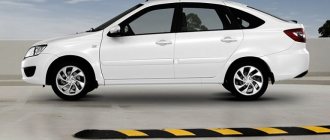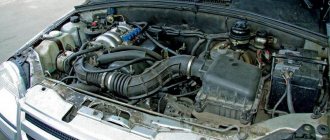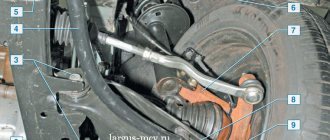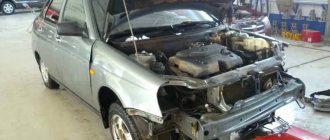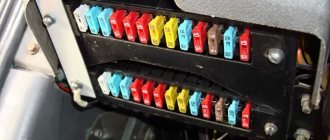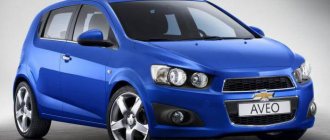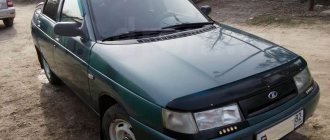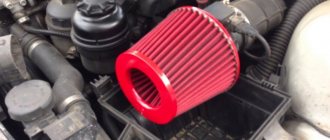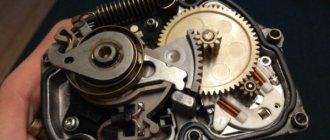Chevrolet Aveo is a class “B” car according to the European classification. It is produced by General Motors and has been on the market since 2003. First, a concept version was presented at the SEMA Motor Show, and soon after, assembly of the production model began. It turned out to be successful, and was produced in 2012 with one restyling. In 2010, the second generation Chevrolet Aveo was presented at the Paris Auto Show. The car was produced in sedan bodies, as well as a hatchback with three or five doors. The model is in quite high demand on the Russian market. Large-unit assembly is organized at an enterprise in Kaliningrad. In this material we will talk about the history of the Chevrolet Aveo model, the technical characteristics of the car, as well as reviews from the owners.
Body
The car was produced in three body styles: 3- and 5-door hatchback and sedan. The latter was modernized in 2006, the hatchback only two years later. The developers failed to hide the outdated design. Proof of this was the results of crash tests according to Euro NCAP. The sedan was tested after restyling. The car earned only two stars, which were reduced to one after stricter requirements.
As a consolation, we can say that the Aveo is adequately protected from corrosion. True, the paint peels off on many specimens, but this does not contribute to the emergence of pockets of corrosion. The exception is the rear trunk door of a hatchback: brown spots appear around the lock and the strip above the number.
What about the interior and body?
The impressive external appearance and, in general, the transition to a more expensive positioning of the Chevrolet Aveo II did not save the car from all-round savings. In particular, all the plastic in the cabin, despite the extravagant design, is inexpensive and hard, subject to squeaks and crickets over time. Painted parts of the interior scratch very easily.
Another ailment of the Aveo is poorly closing doors. This is due to the fact that thin doors do not have enough of their own weight, as a result of which, with a sharp bang, an air bubble forms in the cabin, which can push the light door back. Loose fasteners, which need to be tightened regularly, also do not facilitate easy closing. The problem is treated by making the doors heavier by adding sound insulation, which the Aveo is practically devoid of. Some people manage to make air ducts in the rear parcel shelf, as a result of which air goes into the trunk when the doors are closed. Many people immediately make noise on the wheel arches, since the noise from the tires drowns out all other sounds. From time to time there are problems with heated seats.
But the body is quite strong, resisting corrosion noticeably better than its predecessor, but mainly due to high-quality painting. The emerging areas of rust are associated primarily with mechanical damage to the paintwork. Therefore, it is better to treat chips, abrasions, cracks and dents immediately. Massive traces of rust on the body are most likely a consequence of poor-quality body repairs and poor repainting of elements.
Equipment
All Aveos come standard with a driver airbag, a split-folding rear seat and a height-adjustable steering column. In addition, richer versions have 4 airbags, a music system that plays MP3 files, power steering, central locking and front electric windows. Air conditioning was installed only in the top-end LT trim level, and was available for an additional fee in other versions.
Using the nameplate[edit]
Chevrolet Aveo/Sail (2017–present)
Main article: Chevrolet Sail § Third generation (2016–present)
In several Central American countries, the Aveo nameplate is used on the third generation Chevrolet Sail sedan, which went on sale in Mexico in November 2022 as a 2019 model. [36] [37] The Chinese-made Sail was renamed to avoid its association with the second-generation Sail, which received a Latin NCAP zero star rating in the non-airbag variant. [38]
Engines
The Chevrolet Aveo was offered only with gasoline engines. Unfortunately, none of them are economical. Even the youngest 1.2-liter engine with 72 hp. consumes about 8.5 liters of gasoline in the city. Therefore, it is worth paying attention to engines with a displacement of 1.4 and 1.6 liters - they at least provide acceptable dynamics.
All power units have hydraulic valve lash compensators, and the 16-valve 1.2 liter has a timing chain drive. The vast majority of owners do not complain about the reliability and durability of the motors. True, if you do not take into account minor problems with the ignition system.
Much more inconvenience is caused by the delicate clutch of a manual transmission (the cost of a new one is about 3,000 rubles), and besides, the bearings in the gearbox wear out quickly. In the latter case, it is often more advisable to purchase a used box for 4000-5000 rubles.
Chevrolet Aveo
Story
The original South Korean registration of the Aveo model is not accidental: after official Seoul liquidated the Daewoo company, its passenger car production division was bought by General Motors. The American corporation decided to produce budget cars for developing countries at Daewoo production facilities. Since the existing model range of the South Korean company did not suit the new owners, it was decided to develop new models, among which was Aveo. Initially, the car bore the name Daewoo Kalos, and in other markets it was branded under Holden, Pontiac, Suzuki and Chevrolet.
The first generation was shown in early 2002. And by the end of the same year, the car arrived at dealerships in 120 countries. By the way, Aveo was assembled in eleven countries, including Ukraine and Kazakhstan.
The model that replaced the Daewoo Lanos received a new T200 platform (wheelbase 2480 mm), exterior design from Italdesign, and three body modifications - a 3- and 5-door hatchback and a 4-door sedan.
The design of the cars sold in the Asian and American markets was different from that of the models that were sold in European countries. The differences were in the design of the headlights. For the Asian and American markets, Aveo came with separate turn indicators located below the headlight block, and for the European market - integrated into a common block.
The car was equipped only with gasoline engines. Engines of different sizes were offered for different markets. Thus, a line of power units with a volume of 1.2, 1.4 and 1.5 liters was presented on the European market. The 1.6 liter petrol unit was installed on cars sold in North America, Asia, Australia and Ukraine. These engines were coupled with a 5-speed manual and 4-speed automatic transmission.
In 2005, the model was facelifted, and manufacturers updated only the sedan.
The dimensions of the car and the wheelbase have increased slightly (by 9 mm). Traditionally, the changes affected the front and rear parts of the car (the shape of the false radiator grille, headlights, rear optics, front and rear bumpers has changed). The Aveo sedan also has different door handles. Stylistic changes also affected the interior: a new dashboard was installed and the sound insulation of the cabin was improved. The 1.2 and 1.6 liter engines were also modernized, which became more economical.
Presented in 2007 at the Frankfurt Motor Show, the updated hatchback already had the outlines of the future Aveo generation.
The front part of the car was radically redesigned: the radiator grille was divided into upper and lower halves, and a Chevrolet was installed on the bridge separating them. The headlights have changed, becoming broken-rectangular. The shape of the front bumper has changed, which was now clearly divided into three parts - a wide central one, and two narrow rectangular side ones, in which round fog lights are “encrusted”.
The rear brake lights were also updated, with semicircular reversing lights mounted in the center, and semicircular turn indicators above them. To match the new optics, the shape of the rear bumper was changed, in which a stylized false grille appeared.
The management of General Motors Corporation decided to meet the new decade of the 21st century with a radically updated Aveo.
The presentation of a conceptual model of the new generation of this car took place in 2010 at the Paris Motor Show. The second generation will not be assembled in a number of countries where the previous generation was previously assembled. In the same Ukraine, the assembly of the first generation of the model, which received the name ZAZ Vida, will be established. The new product will be produced in South Korea, the USA, Venezuela and China.
Exterior
The updated Aveo is built on the concern’s fundamentally new Gamma II platform, the base of which is 45 mm longer than that of the previous T200. The model has changed in dimensions. The body length of the sedan increased by 81 mm (from 4318 to 4399 mm), and that of the hatchback by 160 mm (from 3880 to 4040 mm). The car's width has expanded by 25 mm (from 1710 to 1735 mm). And the car added 12 mm in height (from 1505 to 1517 mm).
The exterior design has also changed - it has become more aggressive, primarily due to the new embossed hood of the headlights with separate optics and the “scowling” false radiator grille. It is divided, like the 2007 hatchback, into two halves - upper and lower. The bumper has a different shape, as do the niches for the fog lights located in it. The wheel arches have become more convex and athletic. The design of the trunk lid, rear optics and bumper has completely changed. The exterior of the hatchback in the front part is no different from the sedan.
At the rear, compared to the 2007 hatchback, there have been noticeable changes: the tailgate and taillights have a different shape.
Interior
Dramatic changes have occurred in the interior of the model. First of all, the space in the cabin and luggage compartment has increased (due to increased dimensions) (by 100 liters for the sedan, and by 70 for the hatchback). The interior trim materials and seat upholstery have been significantly improved. The design of the cockpit has changed significantly.
The analog instrument panel was replaced by an electronic-analog one (analog tachometer + digital odometer), and a new steering wheel appeared.
The center console has been significantly transformed with plastic edging on the sides in a “chrome” look. A niche for small items appeared on top, and a new audio system was located in the center. The climate system control levers have also changed, a double-leaf glove box has appeared, in the upper compartment of which there is a connector for an iPod.
In addition, a niche has appeared under the front passenger seat, where it is convenient to put documents. Already in the basic version, the model is equipped with driver and front passenger airbags, an immobilizer, central locking with remote control, air conditioning, and an audio system with controls on the steering wheel.
Specifications
The new Aveo is equipped with modern, economical engines, including a 1.3-liter diesel engine produced by Fiat (supplied to all markets except the CIS countries). Moreover, the diesel engine is available in two modifications – developing 74 and 94 horsepower, respectively. The more powerful engine is coupled with a 6-speed manual transmission, and the less powerful one is paired with a 5-speed automatic transmission.
Among gasoline engines there are engines of 1.2, 1.4, 1.6 and 1.8 liters. Models with 1.4 liter turbocharged and 1.8 liter naturally aspirated engines are supplied only to the US market.
On the CIS market, the model is available with a 1.6 liter engine, which is combined with either a 5-speed manual or a 6-speed automatic.
More details
Is it worth buying?
The first generation Chevrolet Aveo does not deserve much attention. Many competitors offer better levels of safety and comfort. But, if someone is looking for a cheap and well-maintained car, then this option should not be discounted. A well-equipped Aveo from the first owner with low mileage and at an attractive price is a tempting offer.
Performance characteristics
Chevrolet Aveo has high characteristics that were developed taking into account all vehicle safety requirements. This makes it possible to consider it the most reliable in this class. The performance characteristics are described in the table below.
| engine capacity, l | 1,2 | 1,4 | 1,6 |
| checkpoint | Mechanics | manual / automatic | manual / automatic |
| acceleration to 100 km/h, sec. | 13,4 | 12,2 / 13,1 | 11,3 / 11,7 |
| maximum speed, km/h | 171 | 177 / 175 | 189 / 186 |
| fuel consumption per 100 km, l | 5,5 | 5,9 / 6,8 | 6,6 / 7,2 |
Typical faults and problems
— rapid wear of suspension elements. Fortunately, repairs are very cheap.
- light bulbs often burn out. The problem concerns, first of all, low beam and dimensions. In a sedan, access to them is difficult: the easiest way to get there is to remove the headlight.
— poor quality of paintwork: the paint soon chips, but the body does not bloom in places where it is chipped.
- wear and tear of the floor covering.
